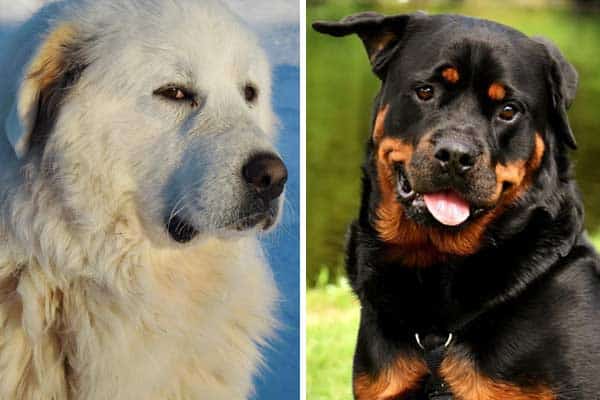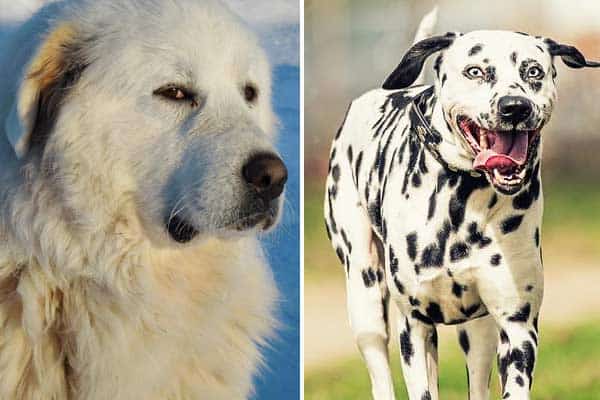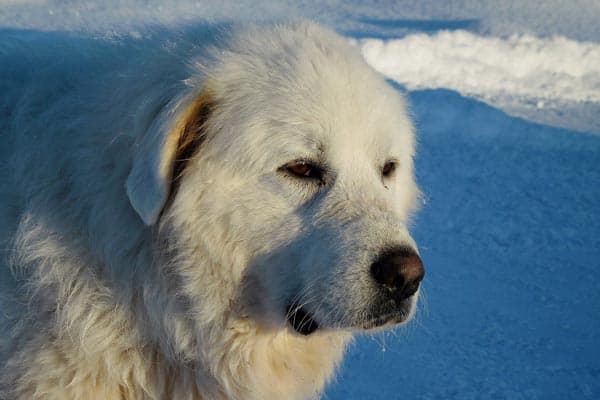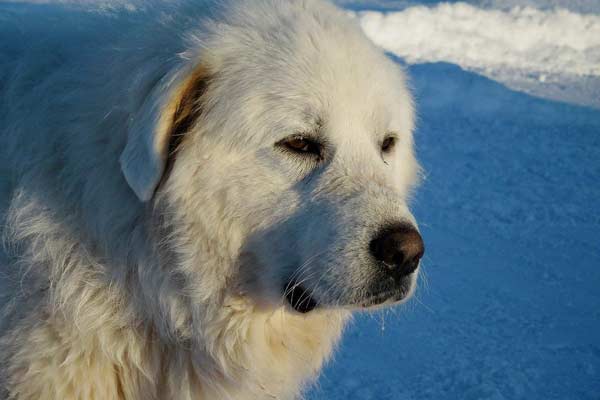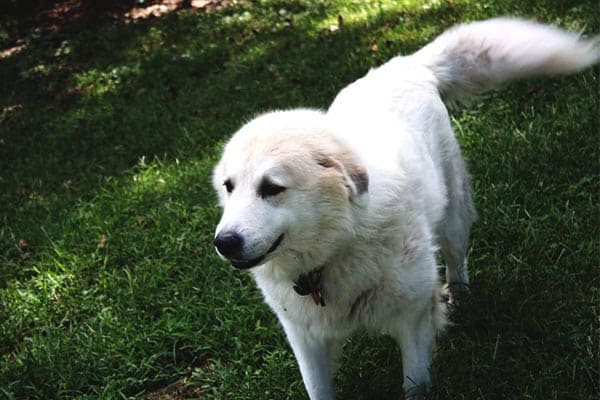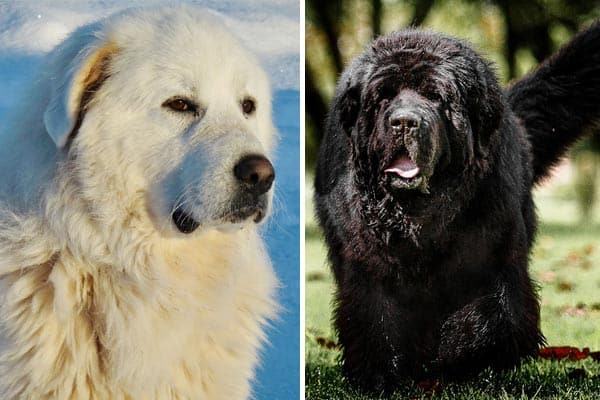Great Pyrenees Wolf Mix: Should Give Pause – Get the Facts
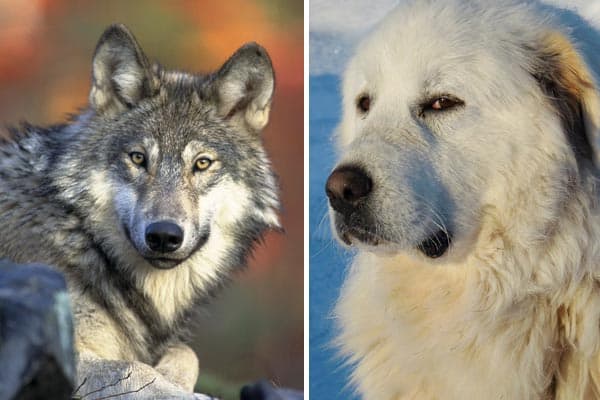
Everyone familiar with dogs has at least heard of the wolf mix. German Shepherds, Siberian Huskies, and Alaskan Malamutes seem natural choices to cross with wolves, and you can easily imagine the physical appearance of such an animal.
Do you ever think about the Great Pyrenees or other LGDs that spend so much time alone with their flocks in areas where wolves potentially roam? Would such a meeting ever occur and what would the offspring be like?
The Great Pyrenees wolf mix is not as common as some of the other wolf hybrids, but it occasionally can happen.
Most wolf hybrids involving the Great Pyrenees are probably orchestrated by humans, but accidental crossbreeding on the range can also potentially take place.
Since both canids are close in size, you predictably get a large but balanced wolfdog with a medium frame.
The temperament of such a pup can be highly unpredictable, but you can count on a highly intelligent animal with a high prey drive and other wild tendencies.
How do you get a Great Pyrenees wolf mix?
Background: Scenario for Natural Mating between Great Pyrenees and Wolf
Despite their close relationship and their access to each other in the field, crosses between Great Pyrenees working dogs and wolves do not occur frequently.
Interspecies breeding is especially rare when wolf populations are stable. The gray wolf’s pack dynamic usually adheres to one breeding pair and mating outside that structure is not usually done.
As wolves succumb to hunting pressure and become scarce, crossbreeding with domesticated dogs is more likely.
Interspecies breeding is also inhibited by the Great Pyrenees’ protective instincts. Additionally, shepherds often have a pair or trio of Great Pyrenees, and a male will discourage opportunistic male wolves.
Of course, working male Pyrs are sometimes free to seek female wolves but are unlikely to expose themselves to that level of risk.
Wolves do not emit the same pheromones or behavioral signals as do domesticated dogs and thus probably do not pose as much of a temptation for Great Pyrenees males as you would think.
Not to mention, the territorial protectiveness of a pack deters other canids from venturing too close.
That being said, wolves become more social, playful, and submissive around domesticated dogs if they are isolated, as is the case with persecution via hunting. In these situations, breeding with free-roaming dogs like LGDs is more prevalent.
Scientists have proven that overall admixture worldwide is rare between wolves and dogs. In isolated locales, wolfdogs exist in measurable numbers both in domesticated dogs and wolf populations.
Human Made Wolf Hybrids
Wolf hybrids have a certain appeal to a sizeable sector of the population. People frequently use different dog breeds to create wolf hybrids and are the most common source of the Great Pyrenees wolf mix.
The most common dog breeds that fanciers use to create a wolf mix are the Alaskan Malamute and Siberian Husky. German Shepherds are utilized frequently as well.
These breeds already look a lot like wolves. They will consistently create puppies that give enthusiasts the closest feeling of owning an authentic wolf.
Great Pyrenees are not used as often in the mix because the results are much more unpredictable. While you will surely be able to tell that you have a wolf mix, the ears might be floppy or the tail wrong.
The most used wolves are red, Eastern, gray, and Ethiopian species.
What does the Great Pyrenees wolf mix look like?
The Great Pyrenees is medium in bone with sturdy limbs, a body slightly longer than it is tall, and a muzzle and back skull of equal lengths. You will note dark eyes and rather small ears that lay flat against the head.
A Great Pyrenees’ coat is abundant with two layers, the outer forming a mane around the neck and shoulders, feathers on the front legs, pantaloons on the backs of the thighs, and heavy plumes on the tail. Pyrs carry their tails down in repose or during work.
However, most carry their tails in a wheel formation over the back when working or otherwise alert.
The chest is broad and deep, and the croup is slightly sloping. There is a moderate uptick of the abdomen from the last of the ribs to the hips.
These dogs have a gradual slope to their foreheads which makes the stop imperceptible. The head is a blunt wedge with a slight rounding of the crown.
A wolf mix will usually show at least one of the following deviations from the purebred Great Pyrenees.
- Longer, narrower muzzle
- More triangular face
- Eyes closer together, more obliquely set, and may be yellow or amber
- Ears larger and can be upright
- Neck longer
- Chest narrower
- Wolfdog leggier and leaner
- Double coat shorter and less abundant
- Tail carried up with less plumage and not as much of a wheel
- Colors may range beyond primarily white – silver, wolf gray, sable, or black; colors often lighter than are customary for wolves or have large white markings
- Pups can grow up larger than either parent – 25 to 30 inches tall, 100 to 150 pounds
What is a Great Pyrenees wolf mix’s temperament?
The wolfdog’s temperament is notoriously variable. Some act just like their dog parent while others act much like wolves. What you get is often tied to the percentage of wolves that a mixed dog has in its bloodlines.
Great Pyrenees wolf mixes may have a higher percentage of wolf than other hybrids to maintain more of an exotic look.
A higher percentage of dogs would give you a better chance of a more tractable disposition, but you might get a look that defeats the purpose of why you wanted a wolf mix in the first place.
Breeders can adjust the percentage of wolf in their dogs by crossing two hybrids. Examples follow:
- 50% GP: 50% wolf x 50% GP/50% wolf => 50% GP: 50% wolf
- 50% GP:50% wolf x purebred GP => 75% GP x 25% wolf
- 50% GP:50% wolf x 25% GP: 75% wolf => 37.5% GP: 62.5% wolf
Be aware that trying to mathematically determine a hybrid’s wolf content assumes a linear and predictable exchange of wolf and dog DNA in each pup, and this does not always happen.
You can usually estimate wolf content based on the parents. However, in rare cases, a pup can receive all wolf genes or 100% dog DNA regardless of the wolf content of the parents.
According to W.O.L.F Sanctuary, the only guarantee is with the cross of a purebred Great Pyrenees and wolf when you will get a 50:50 wolfdog.
Appearance and DNA tests are not reliable either but using multiple methods together can give you a reasonably accurate prediction of the wolf content in a single pup.
- Low content (below 50% wolf) – has many physical features of the Great Pyrenees such as a minimally marked white coat, hanging ears, a shorter and broader muzzle, dark and rounder eyes, a curved tail, or a wavy coat
- Mid content (50% to 85% wolf) – a somewhat even mix of wolf and Great Pyrenees physical traits
- High content (85% to 99% wolf) – looks like a purebred wolf; if there are Great Pyrenees traits, they are subtle
Great Pyrenees wolf mixes and other wolfdogs are also graded based on how far the generation is removed from the original breeding of purebred wolves with purebred dogs.
They are designated as F1, F2, F3, and so on, just like Labradoodles. The higher the F level, the greater the chance the wolfdog has of retaining more dog characteristics. A full discussion is beyond the scope of this article.
- F1 – Great Pyrenees x wolf
- F2 – Great Pyrenees wolfdog x Great Pyrenees wolfdog
- F1b – Great Pyrenees wolfdog x Great Pyrenees OR Great Pyrenees wolfdog x wolf
- F3 – F2 x F2
This Czechoslovakian Wolfdog began long ago as a Czechoslovakian GSD and a Carpathian wolf. It took three or four generations to develop a consistent working dog.
Today the dog has less than 10% wolf and has noteworthy pet-like qualities. However, look at how much it still resembles a wolf.
The Great Pyrenees is a loyal and affectionate breed that is nurturing, protective, and patient with livestock, family members, and children.
It is also independent and strong-willed. Lack of training and socialization can lead to overprotectiveness, aggression, shyness, and excessive roughness with livestock.
Wolves enjoy a much more cohesive pack structure than domesticated dogs and have instincts and ingrained behaviors that are not influenced much by socialization or training.
Although the roles of alpha dogs may not be as important as what was previously believed, there is still a hierarchy that pack members frequently challenge.
Wolves are always searching for weaknesses not only for their advancement but to maintain the strength of the pack.
Moreover, wolves are apex predators that hunt as a cooperative unit. They cover miles of ground regularly both searching for and pursuing prey. Their activity levels and stamina are boundless.
Mid-content and higher wolf-dog mixes usually exhibit at least one of the following traits.
- Natural fear of people – suspicious of strangers
- Shyness
- Aggression against dogs; often get along with large dogs their size if acclimated
- High prey drive
- Challenge your authority constantly
- See children as prey
- Difficult if not impossible to train completely
- Not amenable to housebreaking
- Restlessness
- Unhappiness with being indoors
This looks like a mid-content Great Pyrenees wolf mix. The dog’s shyness or skittishness is evidence.
Note the coat is wolf-like in density and coloration, and the dog has a light-colored head.
The tail wants to curl up like a Pyr. Evidently, this wolfdog has many dog-like characteristics although it may not be completely comfortable in the house.
Pros and Cons of Owning a Great Pyrenees Wolf Mix
Any wolf hybrid will have challenges of ownership but can also be rewarding with the right owner and a lot of luck.
Reasons Not to Own a Great Pyrenees Wolf Hybrid
- Large, powerful animal
- Illegal to own a wolf hybrid in many places
- Wolf hybrids typically require a lot of expertise and for all intents and purposes are wild animals
- Training methods that are effective for domesticated dogs do not work for wolves
- You are not likely going to be able to provide a wolfdog with enough exercise to make it happy
- Not good for city living
- Extreme predatory drive – may kill cats, livestock, and other dogs; not safe around children
- Alpha individuals will constantly test you
- High drive to escape
- Require advanced fencing because the liability is high – eight-foot fence with underground barriers as well; note, the Great Pyrenees requires similar fencing because of its tendency to want to escape and roam
- More destructive than purebred dogs
- Small socialization window – much smaller than dogs
Reasons to Get a Great Pyrenees Wolf Mix
- Exotic beauty
- Bond with a wild animal
- Those that can be successfully socialized and trained make a great jogging or hiking companions – no lack of energy or stamina
- Do fine outdoors even in harsh conditions if they have access to shade and water
- Independent
How do you care for a Great Pyrenees wolf mix?
Despite how romantic it sounds, owning a Great Pyrenees wolf hybrid is a full-time commitment beyond the scope of most dog and wolf lovers. We already mentioned liability and fencing requirements, but there are many special care considerations.
Great Pyrenees Wolf Mix Grooming
Taming a wolfdog enough to brush her double coat can prove a challenge. If your pet is leery of people, grooming may not be an issue you want to push.
Many wolfdogs have fur that is self-cleaning and not prone to matting. If they exercise enough, they do not need nail trims either. Great Pyrenees wolf mixes that need attention to their ears, nails, or coat may require anesthesia under the care of a veterinarian.
Some wolfdogs become accustomed to grooming if you start at an early age or if they have low wolf content (below 50% wolf blood).
Great Pyrenees Wolf Mix Feeding
Obtaining nutrients from corn protein and other grains is an ability that dogs have acquired but not wolves. About 60% of a wolf’s diet in the wild is meat.
As you might guess, Pyr wolfdogs should eat raw meat and bones. In addition, you may need to supplement vitamins and minerals.
Some wolfdogs like berries, and all need access to grass presumably to help with digestion and intestinal upsets.
Some owners also feed kibble, but wolfdogs should get at least three pounds of meat a day depending on age, emotional stress, and activity levels.
A large dog such as the Great Pyrenees wolf mix may require as much as five pounds of meat and bones daily.
Keep in contact with your veterinarian or a nutritionist about what you should feed your wolf-dog and about properly scoring his body condition. Wolves have adapted to survive on little food relative to their activity.
Great Pyrenees Wolf Mix Exercise
Great Pyrenees wolfdogs need three to four hours of exercise daily. Some of this can be your interactions with the animal if she allows it.
Since walking and running on a leash is impractical for most wolfdogs, you must ensure your pet has sufficient outdoor space to stretch her legs.
Mental Stimulation
Keeping your wolfdog from becoming bored can be challenging, especially if he has a lot of wolf traits. Building a habitat and acquiring two wolfdogs or more works best.
Your enclosure should be complete with boulders to climb on, shrubs to chew, a place to build a den, toys to play with, and grass to roll in.
With a low- or low-percentage mid-content wolf (50% to 65% wolf), training is something you should engage in regularly to establish a bond and provide additional mental enrichment.
Enclosure
Unless your Great Pyrenees wolf mix is a proven docile pet with a dog-like personality, you need to approach her as any exotic or wild animal.
Exotic pets require species-appropriate habitats and enclosures that keep them and those on the outside safe.
Wolfdogs require at least half an acre of space, and two will need a full acre. A double gate is the most effective entry point and should have locks.
Concrete and mesh buried below the fence line along its perimeter are effective to keep Great Pyrenees wolf mixes from digging out.
Fence rollers or angling the tops of the fence inward should prevent your hybrid from climbing over the barrier.
Do not place trees or high boulders near the fence. Once you ensure your wolfdog cannot escape, you need to provide shade, runoff pathways to prevent flooding, and a water trough. A wading pool is a nice amenity.
Are Great Pyrenees wolf Mix healthy?
Great Pyrenees wolfdogs can be prone to several infectious dogs because many of them must be housed outdoors, and owners may feel confusion over what a proper vaccination protocol should be.
Experts recommend that you vaccinate wild canids and wolfdogs as you would a domesticated pet.
However, you should realize that the USDA does not recognize the efficacy of vaccinations in wolves or wolf mixes. This is most relevant for rabies, whereby a wild canid is often euthanized and tested if it bites someone.
Great Pyrenees wolfdogs can also suffer health issues you might expect in large breed dogs.
- Parvovirus – a life-threatening virus of the intestinal tract in puppies; causes vomiting and bloody diarrhea
- Distemper – an often fatal respiratory disease of pups; included in a vaccination administered over a few months
- Hip dysplasia – not common in this mix
- Dental disease from insufficient diet
- Heart disease – may also be associated with an inappropriate diet
